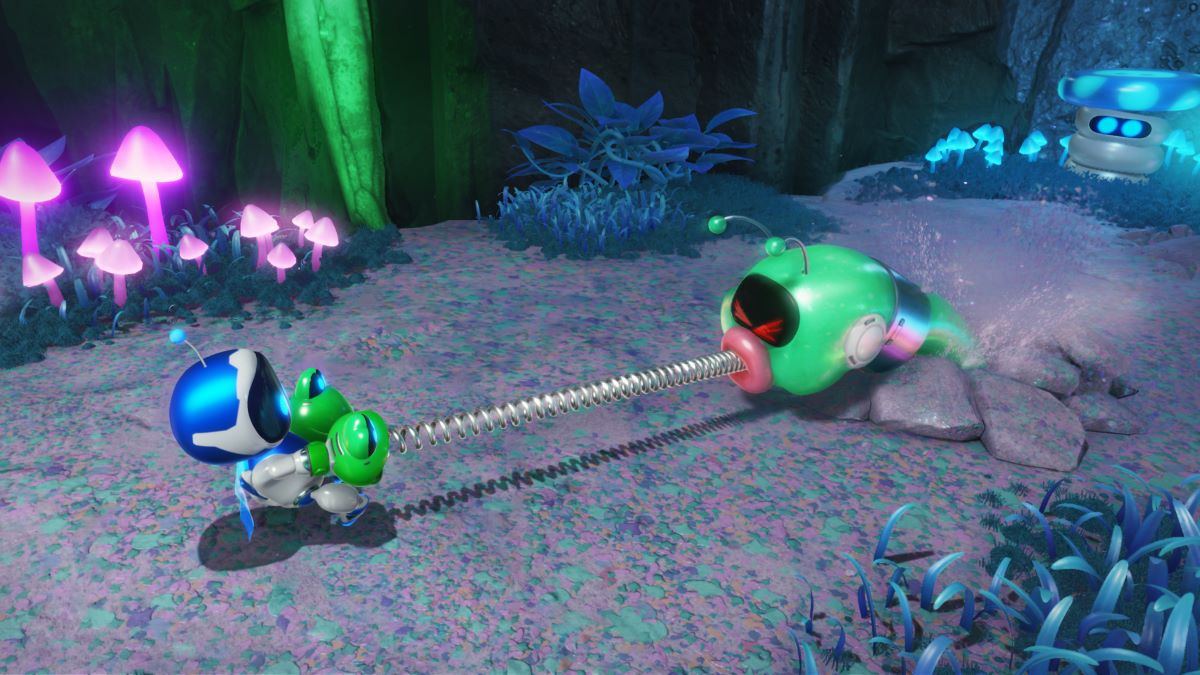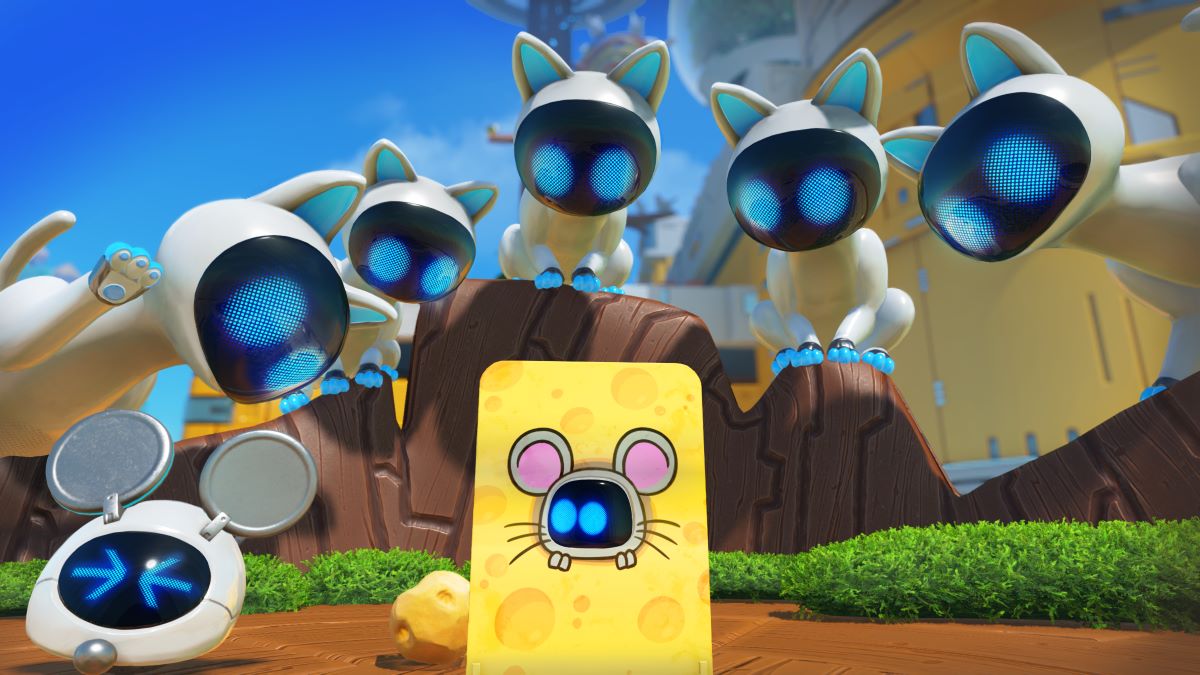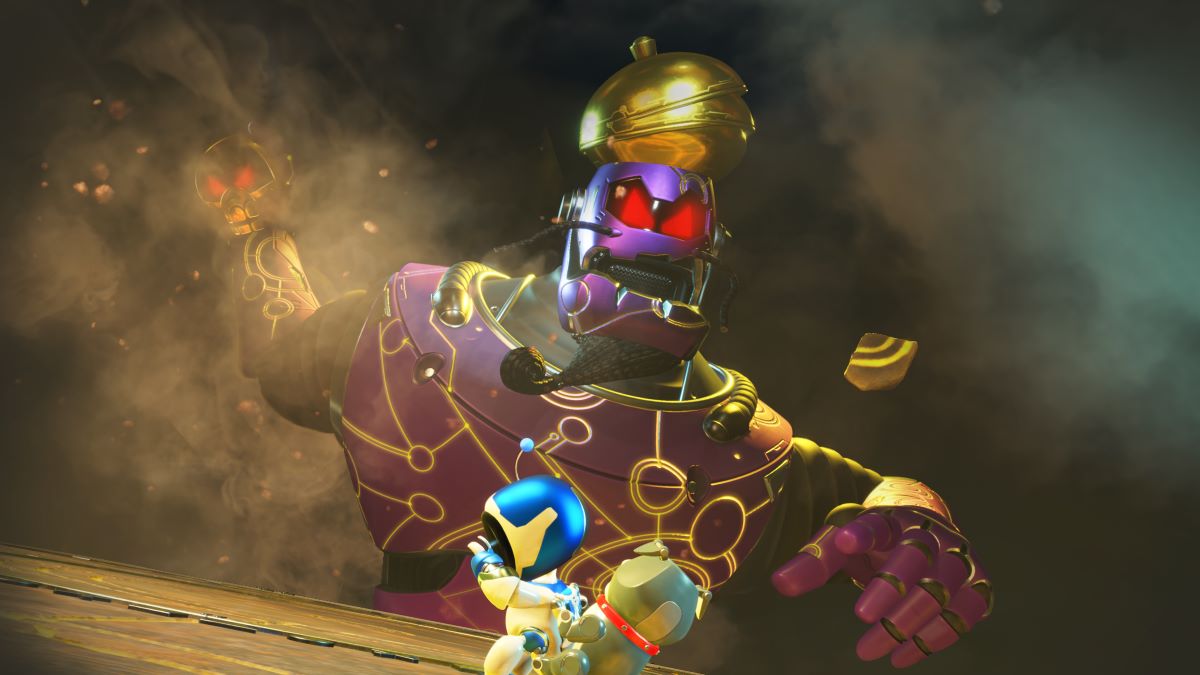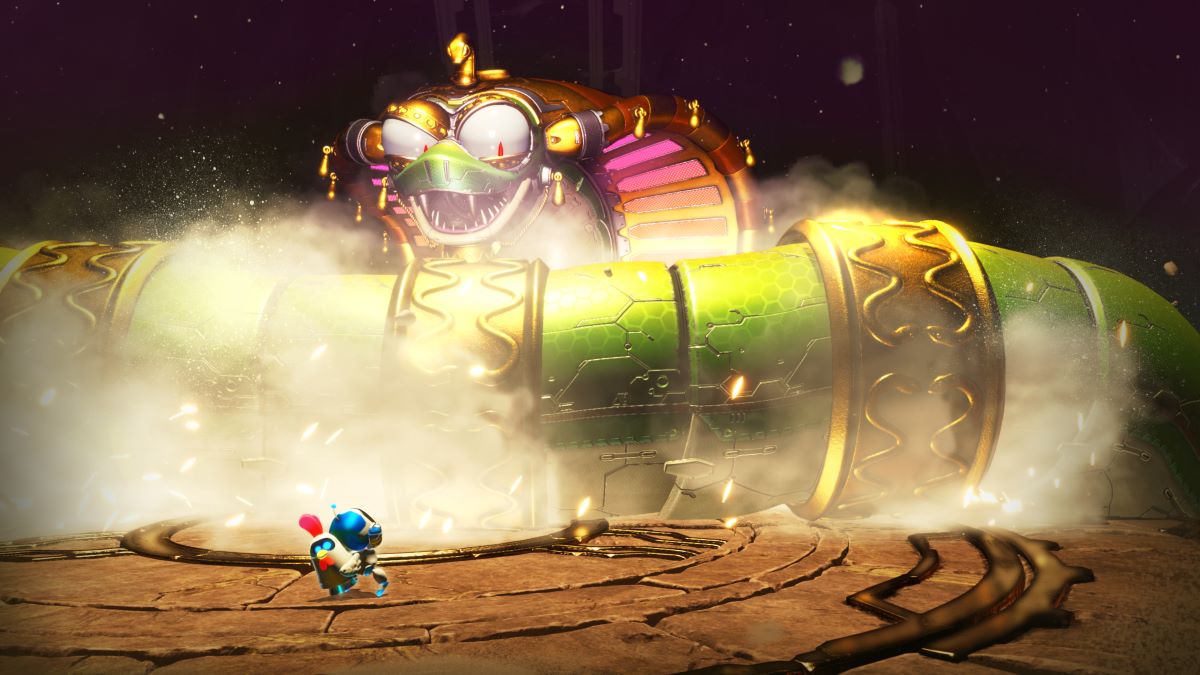It seems like ages ago that we were unboxing the first PlayStation 5 and testing out the many nuances of its controller with a glorified tech demo called Astro’s Playroom. Filled with squeaks and innocent gameplay, Astro’s Playroom may have unintentionally started a need for more of Astro’s adventures and made the small dude an icon for the Sony PlayStation brand. Like, a Crash Bandicoot icon from the 90s. Epic, memorable, and playful.
Now, after two tech demos, one on the PSVR (still waiting for the PSVR2 version – c’mon, Sony!), Sony and developer Team Asobi are set to release their 15-hour dedicated game, Astro Bot, on the PlayStation 5 that propels Astro beyond tech demo status and sends him into a Mario-esque structure of multi-level mayhem with a replayable aspect pushed along by rewarded exploration. Along the way, the game contains a healthy amount of positivity, joy, and a reminder that the video game world can still bring mindless fun to make someone’s gloomy day a bit more sunshiny.
So, sit back, get that controller ready to rumble and tumble, and let’s discuss the many aspects of Sony’s and Team Asobi’s permanent fixture in its PlayStation world.
Simple, fun story
Astro Bot is driven by a simple and fun story. Astro’s world has come crashing down, as the PlayStation mothership containing him, and his many robot colleagues has been ripped apart by a green glob of an alien. Certainly, not a nice thing to do to a ship or its many residents.
The PlayStation ship, which is mangled and in shambles, has its parts fall everywhere around the Astro Bot universe, along with most of the ship’s residents. Astro must find/pick up all those pieces, including his friends, to help get their travel back on track.
The story of Astro Bot isn’t too complicated with its structure and does enough to justify the adventure laid out for the happy robot. Its narrative is on par with any Mario game and doesn’t over-complicate the style of the adventure with unnecessarily deep drama or overwhelming details. The game is built for audiences that just want to play and have fun, and the story does enough to get the player to that level. The fact that the game goes meta with its actual hardware and gives cute context to the PS5’s design helps to make the simplicity of the story more enjoyable, if not familiar. The amount of self-awareness in the game is thick and it’s used well in all sorts of cute manners.

In short, it’s a fun platformer story that sprinkles in a hefty amount of positivity, and self-awareness and doesn’t stray too far from what was originally established in Astro’s Playroom. It is doing exactly what it needs to do to get things going. The only thing it is missing is maybe a Bowser-sized consistent antagonist that will be a villainous staple for years to come. Maybe it will get there in the next iteration but for now, the story does enough to give the adventure rhyme and reason.
Out-of-this-world-level design
While the story is simple and fun, the game doesn’t rest on its laurels trying to impress the player through its meta and cuteness. The biggest plus for Astro Bot is how its levels are designed. Honestly, any good platformer concentrates on this aspect before moving on to any other part of its game. Sure, you could argue that it starts with mechanics, but I will have to humbly disagree. Mechanics are driven by level design and there is nothing you can say that will change my simple mind.
Astro Bot doesn’t waste a breath while impressing through its level design. The structure of the game relies on a vast universe for Astro to traverse. The levels are broken up into galaxies, which contain 4-5 sub-levels (planets) that lead up to one gigantic boss level. Each galaxy is given a personality that shapes the rest of the levels. For example, there is a galaxy that is built on Sony’s classic title Ape Escape, where multiple sub-levels are Ape-related and include such things as a construction site to jump around and a jungle area that reminds us that danger is on the loose. Even if it is a bunch of wacky apes.
These sub-levels are filled to the brim full of unique fun and show off Team Asobi’s creativity through complicated and entertaining design that flows well together. One of my favorite levels in the game was based on God of War. The main picture of the review tells you most of the story, but let me throw out some more details here.
The God of War level used elements from GoW Ragnarök across several sub-levels. For example, there was a sub-level that traversed the frozen tundra found in the actual Ragnarök game that featured Jörmungandr (the world serpent) and several enemies dressed up as baddies from the GoW game. To boot, this set of levels also allowed Astro to use Kratos’ axe and implement its frozen capabilities into level obstacles and solutions. It was fun and brilliant, and it was all backed up with a soundtrack that emulated the magnificent one found in the original game.
While some of the levels in Astro Bot borrowed from the PlayStation family of games, others went their own route and were equally fun. For example, there was a multi-tiered underwater level that played around with dangerous sea creatures and slow-moving gameplay for the most part. The latter of which was a change of pace in comparison to most Astro Bot levels. The underwater level’s girth and unique style captured a deep-sea adventure, and not an ounce of space felt wasted.

The level design in the overall game was stellar. It set a new bar and future expectations for Astro games to come. I wasn’t at all bored during my adventure through the main levels and felt like there wasn’t a moment during my playthrough where levels were repeating or where Team Asobi threw in the creative towel. The game contained a constant stream of unique experiences that were a treat to play. And you better believe I will be replaying them.
More than meets the eye
While the main levels of the game were entertaining and the only pattern to them was how you climbed up a universal ladder towards a massive boss fight, there are some ‘off the beaten path’ moments in the game.
Occasionally, you will pull out of a sub-level and back to the galaxy only to see some random asteroid or object floating in space. Most of the time, you can touch said object and find a secret world to play within. These appear at random but always bring a reward to the table and a chance to extend the gameplay, which might be short in comparison to other 3D platformers out there.
Some of these extra levels can range from short stints of jumping, taking out enemies, and finding a robot that needs rescuing. Sure, these levels are short and linear, but they are still a fun little side gig that adds just a bit more to the Astro plate.
But then other levels offer more.
There are hidden levels that open multiple other levels that truly challenge the player. For example, there are a few hidden levels early on that are represented by odd alien triangles (four in total) that split off into their own set of levels. Each one of the triangle levels gives you a hefty amount of difficult design that could only make FromSoftware developers thrilled. We are talking about multiple ways to fail and purposefully designed disastrous moments that will test a player’s frustration meter as much as their skill. These levels can be downright frustrating at times to the point where you might need a break from them, but much like the main level designs, they are equally as creative and unique with each experience.
These additional levels are great fun and add extra value to an already entertaining adventure.
Powering up
While Mario mechanics started out a long time ago with just running, jumping, and powering up two ways (fire and growing big), 3D platformers have evolved over time to include more creative solutions to make the gameplay mechanics unique. Astro Bot is no different with what it brings to the table in terms of power-ups.
The power-ups in this game are based on the worlds you explore. For example, there is a set of levels where you must go up onto large structures. To do this, you are given a chicken backpack that allows you a powerful burst upward with a small amount of flying involved. This power-up allows you to use Astro’s head as a leading point to flip platforms or cause major enemy destruction. The level with this power-up is designed around that chicken, which means that everything you do is specifically involved with it. Most levels work this way, as they offer up a design built around whatever new and temporary power that Astro totes. While it’s sad that you can’t retain the power-ups and use them across multiple levels, it’s understandable why they are temporary in purpose.
The power-ups in this game are insane as they are creative. For example, there is a power-up that allows Astro to become a giant sponge that soaks up water. There is a penguin power-up that allows Astro to swim better underwater. There is even a power-up that has Astro don gator gloves that grab and chomp their way around through enemies and obstacles. The style, purpose, and creativity of these power-ups is brilliant as they are well thought through in relation to the levels they drive. The power-ups add so much to the gameplay experience.

Little repetitive
If I must give criticism to the game, it would be the repetitiveness of common enemies. There are a finite number of enemies in the game outside of the main bosses (who are brilliant). The common enemies tend to just get a different set of clothes for each level but generally react and attack the same way. For example, there is a treasure-hunting level that has enemies dressed in metal helmets, but they react the same way as if they weren’t on that level. The God of War level has them dressed up as God of War enemies but still come at Astro the same way. The costumes are cute and funny but ultimately you will find Astro just essentially running into the same common enemies repeatedly. While there are a few unique enemies to each type of level, most of what you run into is repeated.
Now, having said that, and going back to an earlier comment, the main bosses are fantastic. You will find different bosses that have unique attack patterns that are a treat to fight against. For example, in a desert level of the game, you will run into a giant cobra that is as vicious as it is crazy. Her attack pattern falls into four categories – using her tail to try and sweep you off a platform, throwing acid/poison at you to melt platforms you’re on, trying to ram you full force to knock you off the platform, and spitting acid/enemy-filled eggs at you. That doesn’t even cover the final phase of her attack, which I won’t mention.
Each boss has their own set of attacks, and each attack is geared towards the level they represent and the character they are. They’re certainly something to work towards and are gratifying once you unlock them and face them. In short, most of the common enemies are repeated, but, damn, those bosses are bosses.
Unlocking and the home base
As you can probably guess, there is more to this game than just simply jumping from place to place and fighting enemies. Along the way, you collect money and collect robots that you rescued. The latter is used to unlock bosses and additional content and can be used to find additional goodies.
To unlock content, such as bosses, you must rescue a certain number of robots. For example, the cobra boss takes a little less than 100 rescued robots to unlock. If you’re a Mario fan, this is akin to collectible stars. As you progress in the game and unlock levels later, that rescued robot number will go up in order to unlock more bosses. As you can probably tell, the game will push you towards replaying levels and being diligent in finding more robots to rescue and unlock more content. It’s like a beautiful circle of effort that counts on you to explore and motivates you to do so while offering a proper payoff that sets off the completionist in your gaming soul. At the very least, unlocking material extends the gameplay of Astro Bot.
If unlocking bosses wasn’t motivation enough to keep searching and rescuing robots, the game also features a home base where you take your found PlayStation 5 parts and offers additional goodies to unlock with money and rescues. The robots can be used to access additional robots trapped in this home base, which is cool because some of the robots you meet are fun parodies of PlayStation-familiar characters (and not all owned by Sony).
The money you gain from levels you explore allows you to unlock more content for your home base, like additional characters or items they use to complete whatever scene they are from. While none of it is necessary to complete the game, it’s still additional fun and something else to do while you complete the experience.

Anything extra in a game, especially of this scale, only adds to the content and makes you want to explore worlds while motivating you to do better within each level. Do I need to complete puzzle pieces or unlock a (company I’m not naming) character to complete Astro Bot? Nah, but darn it’s a fun option to have when I want to take a break from jumping through each level. It’s just good fun and it feels like you’re accomplishing so much with your efforts.
On that sweet note, let’s wrap this review up.
Conclusion
Astro Bot from developer Team Asobi and Sony Interactive Entertainment is a wonderful entry into Astro’s bigger adventure possibilities. The game features creative levels, plenty of personality and positivity, and several reasons to replay it once the main adventure has concluded. While it could have a bit more variety with its common enemies, the bosses, and uniquely built levels deliver more entertainment and joyful meta than should legally be allowed. This is a great big beginning for what should be a long-lasting Sony mascot.





